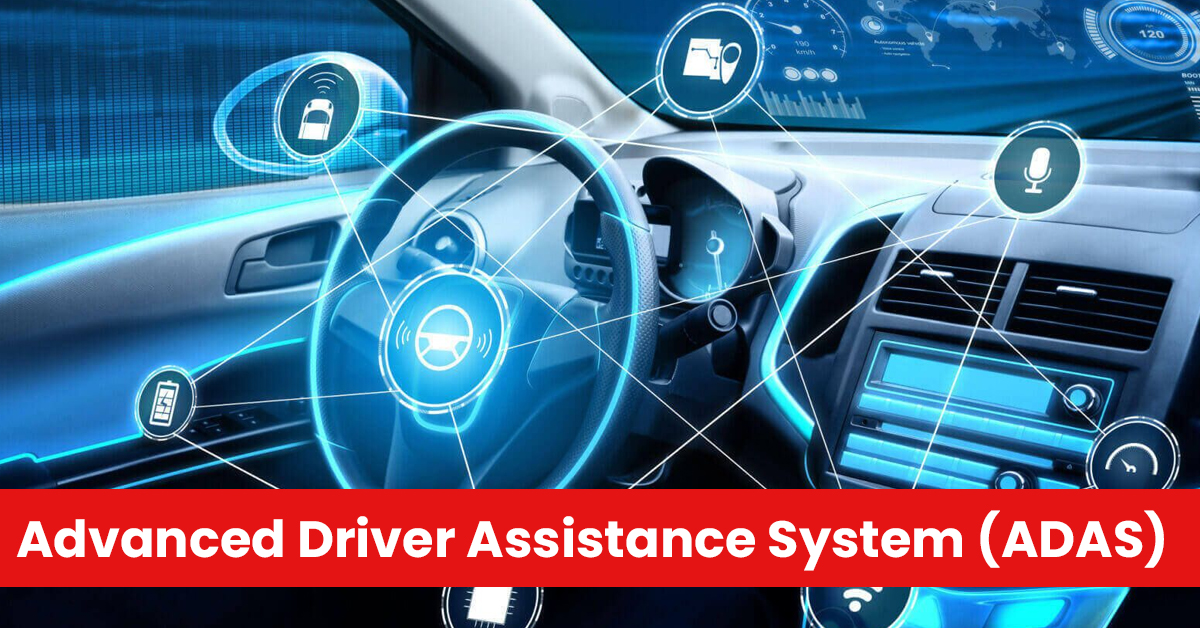Table of Contents
The Advanced Driver Assistance System (ADAS) is a revolutionary technology designed to enhance vehicle safety and improve driving comfort. Using sensors, cameras, and artificial intelligence, ADAS assists drivers in making better decisions, preventing accidents, and ensuring smoother vehicle control.
In the age of smart vehicles and connected mobility, ADAS is paving the way toward autonomous driving and reducing road fatalities across the globe.
What is ADAS?
Advanced Driver Assistance System (ADAS) refers to a set of electronic systems that use intelligent sensors and cameras to support drivers in real-time driving situations.
These systems aim to prevent human errors, which cause nearly 90% of road accidents globally.
ADAS uses a combination of:
-
Cameras (front, rear, and surround-view)
-
Radar and LiDAR sensors
-
Ultrasonic sensors
-
Artificial Intelligence (AI) and Machine Learning (ML) algorithms
How Does ADAS Work?
ADAS integrates data from multiple sensors to monitor the vehicle’s surroundings.
Here’s how it functions:
-
Detection: Sensors continuously scan the environment for obstacles, pedestrians, and other vehicles.
-
Processing: The onboard computer analyzes this data using AI algorithms.
-
Decision-making: Based on the analysis, the system gives warnings or takes corrective actions — like applying brakes or steering adjustments — to avoid collisions.
For example:
When ADAS detects a sudden stop by the vehicle ahead, it triggers Automatic Emergency Braking (AEB) to prevent a crash.
Key Features of ADAS
The level of ADAS in a vehicle determines the extent of automation. Below are the most common features found in modern vehicles:
1. Adaptive Cruise Control (ACC)
Automatically adjusts the car’s speed to maintain a safe distance from the vehicle ahead.
2. Lane Departure Warning (LDW) & Lane Keeping Assist (LKA)
Alerts the driver if the vehicle drifts out of its lane and can gently steer it back.
3. Automatic Emergency Braking (AEB)
Detects potential collisions and applies brakes automatically.
4. Blind Spot Detection (BSD)
Warns the driver when another vehicle is in the blind spot during lane changes.
5. Traffic Sign Recognition (TSR)
Reads and displays road signs on the dashboard to keep the driver informed.
6. Driver Drowsiness Detection
Monitors the driver’s attention level and suggests breaks if signs of fatigue are detected.
7. Rear Cross-Traffic Alert
Assists in reversing by detecting cross-traffic movement behind the car.
Levels of ADAS Automation
According to the Society of Automotive Engineers (SAE), ADAS is categorized into six levels:
| Level | Automation Type | Description |
|---|---|---|
| Level 0 | No Automation | Full control by the driver |
| Level 1 | Driver Assistance | Basic features like cruise control |
| Level 2 | Partial Automation | Steering and acceleration assist |
| Level 3 | Conditional Automation | Car handles driving, but driver must intervene |
| Level 4 | High Automation | Car drives itself under specific conditions |
| Level 5 | Full Automation | Complete self-driving without human input |
Most modern cars currently fall under Level 2 or Level 3 automation.
Benefits of ADAS
-
Improved Safety: Reduces human errors and accident risks.
-
Environmental Impact: Optimizes driving patterns, reducing fuel consumption.
-
Driver Awareness: Alerts and assists drivers to make better decisions.
-
Cost Savings: Fewer accidents mean lower insurance premiums and repair costs.
-
Enhanced Comfort: Automation reduces fatigue, especially during long drives.
Challenges in ADAS Implementation
While ADAS is a game-changer, its widespread adoption faces several hurdles:
-
High cost of sensors and maintenance.
-
Weather dependence — heavy rain or fog can affect camera and radar accuracy.
-
Infrastructure limitations in countries like India (poor lane markings, uneven roads).
-
Driver training and awareness about system usage.
ADAS in India: The Emerging Market
India, with one of the world’s highest road accident rates, stands to benefit immensely from ADAS.
Major automakers like Tata Motors, Mahindra, Hyundai, and MG have started integrating Level 2 ADAS in their vehicles — such as:
-
MG Astor
-
Hyundai Tucson
-
Honda City e:HEV
-
Mahindra XUV700
-
Tata Harrier and Safari (2024 models)
As per industry experts, ADAS could reduce accident-related deaths by 25–30% if implemented on a large scale.
Future of ADAS
The future of ADAS lies in AI-powered autonomous driving systems, Vehicle-to-Everything (V2X) communication, and 5G connectivity.
With rapid advances in sensor technology and government support, India is moving toward smart mobility and safer roads.
Conclusion
The Advanced Driver Assistance System (ADAS) is more than just an automotive feature — it’s a step toward intelligent and autonomous transportation.
By reducing human error, saving lives, and improving efficiency, ADAS is shaping the future of driving across the globe.
As infrastructure improves and technology becomes affordable, India’s automotive sector will witness a major transformation driven by ADAS innovation.


 Industrial Parks in India: Driving Manuf...
Industrial Parks in India: Driving Manuf...
 National Maritime Heritage Complex (NMHC...
National Maritime Heritage Complex (NMHC...
 Reforming Fertiliser Subsidy in India: N...
Reforming Fertiliser Subsidy in India: N...

























